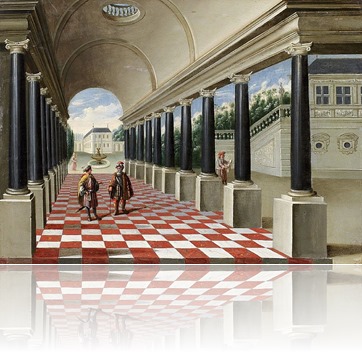I have talked about memory and memorization before, but not about the Memory Palace. What brought it to mind was this passage from Book X of St. Augustine’s Confessions:
And I come to the fields and spacious palaces of my memory, where are the treasures of innumerable images, brought into it from things of all sorts perceived by the senses.
While St. Augustine is waxing eloquent about the beauty and power of memory, he drops this line which contains a relatively inconspicuous idea that is incredibly profound: the Memory Palace.
Several writers have explored the concept of the Memory Palace, how and why to build one, but let me simply just get at what it is: A Memory Palace is an imaginary building you can make in order to store information. Think of it as a mental hard drive from the Middle Ages. Hard drives have sectors where information is stored in chunks, all the way down to bits and bytes. Similarly, human beings can only store information by breaking it down into pieces and filing it away in our minds.
Unfortunately, most of us were never taught how to memorize, we were just given a pile of information and told to memorize it. Memorizing without any technique is what we call “rote” memorization, where a person simply repeats and repeats the information until it sticks. Because rote memorization is so difficult and seemingly fruitless—most of us lose whatever we had memorized in a couple days—a lot of schools have simply given up on memorization altogether. But this is a mistake.
The ancients and medievals had to memorize loads of information because few knew how to read and write proficiently and of those who did, writing utensils and parchment were expensive and hard to come by (kind of like how a pack of sticky notes will cost you ten bucks now, only worse!). So, these people had to compensate with the only computer on hand: the brain. But they weren’t lazy about it. They didn’t just throw their heads at information and hope that the two would stick together. No. They developed battle-hardened techniques over a long period of time. The essential technique is the Memory Palace.
It starts with associating an idea with a physical object like a door, or a chair. One then can “walk” through say, your own house or apartment and stow pieces of information “in” different objects. There are two themes to the technique. One is the word-object association, the other is proceeding through the palace in a certain order.
For example, imagine you had been asked to give a speech on the classification of living creatures. If your house has five rooms, you could put each the five kingdoms in a separate room (Bacteria, Protozoa, Plants, Fungi, Animals) and then each piece of furniture in the room could represent the phyla within that kingdom. As you proceed through this Memory Palace, you could recall each of the phyla of all five kingdoms as you give your speech. In fact, the Memory Palace was the origin of speakers saying “in the first place…” and “in the second place…” The “places” they refer to are the rooms within their memory palace.
I have found it to be a very helpful memorization technique, especially when paired with the link system and other memorization aids (e.g., making exaggerated and silly word-pictures). As our generation copes with information overload (deluge, tidal wave), we have to find ways to remember the information that is important to us, the information we need to use, connect and synthesize, not the trivia we can look up. If we want to avoid becoming Google Glass fixated cell phone addicts who can’t hold a coherent conversation because we’re so distracted with looking things up online, we might need to recover the Memory Palace that St. Augustine stood in awe of and thanked God for saying, “Great is the power of memory; very wonderful is it, O my God.”


Mark, thanks for this little article! I’m thinking that it would be good to be more proactive about memorizing, especially details that are relevant to personal relationships. Not only could the information be used in the service of love, but the mere intention to memorize such things can be an expression of love. “I want to love you, and so I want to know you.”
On a somewhat unrelated note, do you think the memory palace could be useful in developing “perfect pitch”? Initial reading suggests that it wouldn’t help much (the strongest method seems to be learning trigger melodies for each pitch), but perhaps the memory palace could help solidify the associations.
@Jonathan – Great to hear from you on my blog! And yes, I think you’re right on the first point. The memory palace and other memorization techniques are very helpful for personal relationships. We’re always amazed by a person who never forgets our name, but that’s not a mere natural talent. Usually the name-rememberer is intentionally attempting to memorize names and faces when he meets people. That’s an investment of effort that can pay huge dividends. Most of us are pretty good at forgetting whom we meet because we don’t even attempt to remember.
As to perfect pitch, I think you’re onto something, but we’re probably looking at two different kinds of activities here. The first is an association between a heard pitch and a remembered pitch, the second is a kind of “mental filing system” of pitches. To me it seems that memory techniques like the Memory Palace could really help with the second part so that you could be ready with your filing cabinet every time you hear a pitch, but that they won’t help a ton with the hearing portion. I think what would help there is the pitch-color theory stuff that associates a color with each pitch. In fact, I’ve attended a concert at which a piece was performed with a “color organ.” So I would use the colors to bump up the hearing/associating skill and use the mental file box to keep track of all my remembered pitches. Any way you go, you’re in for a lot of work!
I find it best to use both rote and palace, and think that subliminally they are both always at work.
Repetition can be enjoyable, given a bit of rhythm and pacing; a bit of it, gets a thing into the image for a memory palace.
I learned 20 or 30 digits of pi by heart, using nothing but rote, pretending it was like the poem “Jabberwocky” and enjoyed the process. The trick is to let it be fun, to play with it.
And I think that associating things with images takes at least a touch of repeition (rote), though associating thing-image with memory-place-image, needs less; reviewing and refreshing a memory palace, is a form of rote (repetition).
And so, for my part, I’m not inclined to set the two ways in opposition.
Meanwhile, I’m very pleased with, and I thank you for, your present article! Very glad to see purposeful cultivation and use of memory being promoted. And especially the quote from Saint Augustine, what a find: and “fields and palaces” suggests using fields as well as buildings, for memory places – how intriguing! People were far more agricultural in his time (I seem to recall hearing some quote form a church father en route to an oecumenical council who remaked upon hearing the field workers chanting psalms while they worked, as he was passing by). Really: for memory places, why not fields, national parks, forest campgrounds…?
Peace and joy of our risen Savior to you!
I found this article while searching for the Church’s teaching on Memory Palaces; I had only heard of them before as a technique of the heretic Giordano Bruno. Thank you, Mark, and thank you, Saint Augustine, for your clarification!